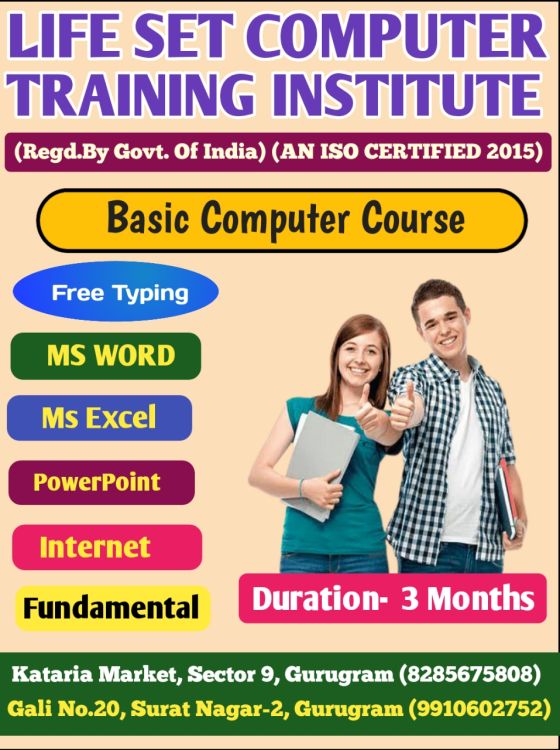
DETAILED SYLLABUS
1. KNOWING COMPUTER
1.0 Introduction
1.1 Objectives
1.2 What is Computer?
1.2.1 Basic Applications of Computer
1.3 Components of Computer System
1.3.1 Central Processing Unit
1.3.2 Keyboard, mouse and VDU
1.3.3 Other Input devices
1.3.4 Other Output devices
1.3.5 Computer Memory
1.4 Concept of Hardware and Software
1.4.1 Hardware
1.4.2 Software
1.4.2.1 Application Software
1.4.2.2 Systems software
1.5 Concept of computing, data and information
1.6 Applications of IECT
1.6.1 e-governance
1.6.2 Entertainment
1.7 Bringing computer to life
1.7.1 Connecting keyboard, mouse, monitor and printer to CPU
1.7.2 Checking power supply
1.8 Summary
1.9 Model Answers
2. OPERATING COMPUTER USING GUI BASED OPERATING SYSTEM
2.0 Introduction
2.1 Objectives
2.2 Basics of Operating System
2.2.1 Operating system
2.2.2 Basics of popular operating system (LINUX, WINDOWS)
2.3 The User Interface
2.3.1 Task Bar
2.3.2 Icons
2.3.3 Menu
2.3.4 Running an Application
2.4 Operating System Simple Setting
2.4.1 Changing System Date And Time
2.4.2 Changing Display Properties
2.4.3 To Add Or Remove A Windows Component
2.4.4 Changing Mouse Properties
2.4.5 Adding and removing Printers
2.5 File and Directory Management
2.5.1 Creating and renaming of files and directories
2.6 Common utilities
2.7 Summary
2.8 Model Answers
3. UNDERSTANDING WORD PROCESSING
3.0 Introduction
3.1 Objectives
3.2 Word Processing Basics
3.2.1 Opening Word Processing Package
3.2.2 Menu Bar
3.2.3 Using The Help
3.2.4 Using The Icons Below Menu Bar
3.3 Opening and closing Documents
3.3.1 Opening Documents
3.3.2 Save and Save as
3.3.3 Page Setup
3.3.4 Print Preview
3.3.5 Printing of Documents
3.4 Text Creation and manipulation
3.4.1 Document Creation
3.4.2 Editing Text
3.4.3 Text Selection
3.4.4 Cut, Copy and Paste
3.4.5 Spell check
3.4.6 Thesaurus
3.5 Formatting the Text
3.5.1 Font and Size selection
3.5.2 Alignment of Text
3.5.3 Paragraph Indenting
3.5.4 Bullets and Numbering
3.5.5 Changing case
3.6 Table Manipulation
3.6.1 Draw Table
3.6.2 Changing cell width and height
3.6.3 Alignment of Text in cell
3.6.4 Delete / Insertion of row and column
3.6.5 Border and shading
3.7 Summary
3.8 Model Answers
4. USING SPREAD SHEET
4.0 Introduction
4.1 Objectives
4.2 Elements of Electronic Spread Sheet
4.2.1 Opening of Spread Sheet
4.2.2 Addressing of Cells
4.2.3 Printing of Spread Sheet
4.2.4 Saving Workbooks
4.3 Manipulation of Cells
4.3.1 Entering Text, Numbers and Dates
4.3.2 Creating Text, Number and Date Series
4.3.3 Editing Worksheet Data
4.3.4 Inserting and Deleting Rows, Column
4.3.5 Changing Cell Height and Width
4.4 Formulas and Function
4.4.1 Using Formulas
4.4.2 Function
4.5 Summary
4.6 Model Answers
5. INTRODUCTION TO INTERNET, WWW AND WEB BROWSERS
5.0 Introduction
5.1 Objectives
5.2 Basic of Computer Networks
5.2.1 Local Area Network (LAN)
5.2.2 Wide Area Network (WAN)
5.3 Internet
5.3.1 Concept of Internet
5.3.2 Applications of Internet
5.3.3 Connecting to the Internet
5.3.4 Troubleshooting
5.4 World Wide Web (WWW)
5.5 Web Browsing Softwares
5.5.1 Popular Web Browsing Softwares
5.6 Search Engines
5.6.1 Popular Search Engines / Search for content
5.6.2 Accessing Web Browser
5.6.3 Using Favorites Folder
5.6.4 Downloading Web Pages
5.6.5 Printing Web Pages
5.7 Understanding URL
5.8 Surfing the web
5.8.1 Using e-governance website
5.9 Summary
5.10 Model Answers
6. COMMUNICATIONS AND COLLABORATION
6.0 Introduction
6.1 Objectives
6.2 Basics of E-mail
6.2.1 What is an Electronic Mail
6.2.2 Email Addressing
6.3 Using E-mails
6.3.1 Opening Email account
6.3.2 Mailbox: Inbox and Outbox
6.3.3 Creating and Sending a new E-mail
6.3.4 Replying to an E-mail message
6.3.5 Forwarding an E-mail message
6.3.6 Sorting and Searching emails
6.4 Document collaboration
6.5 Instant Messaging and Collaboration
6.5.1 Using Instant messaging
6.5.2 Instant messaging providers
6.5.3 Netiquettes
6.6 Summary
6.7 Model Answers
7. MAKING SMALL PRESENTATIONS
7.0 Introduction
71 Objectives
7.2 Basics
7.2.1 Using PowerPoint
7.2.2 Opening A PowerPoint Presentation
7.2.3 Saving A Presentation
7.3 Creation of Presentation
7.3.1 Creating a Presentation Using a Template
7.3.2 Creating a Blank Presentation
7.3.3 Entering and Editing Text
7.3.4 Inserting And Deleting Slides in a Presentation
7.4 Preparation of Slides
7.4.1 Inserting Word Table or An Excel Worksheet
7.4.2 Adding Clip Art Pictures
7.4.3 Inserting Other Objects
7.4.4 Resizing and Scaling an Object
7.5 Presentation of Slides
7.5.1 Viewing A Presentation
7.5.2 Choosing a Set Up for Presentation
7.5.3 Printing Slides And Handouts
7.6 Slide Show
7.6.1 Running a Slide Show
7.6.2 Transition and Slide Timings
7.6.3 Automating a Slide Show
7.7 Summary
7.8 Model Answers
8. FINANCIAL LITERACY FOR BANKING SCHEME AND APPLICATIONS
8.0 Introduction
8.1 Objectives
8.2 Why Savings are needed?
8.2.1 Emergencies
8.2.2 Future Needs
8.2.3 Large expenses
8.3 Drawbacks of keeping Cash at home
8.3.1 Unsafe
8.3.2 Loss of Growth Opportunity
8.3.3 No Credit Eligibility
8.4 Why Bank is needed?
8.4.1 Secure Money, Earn Interest, Get Loan
8.4.2 Inculcate habit of saving
8.4.3 Remittances using Cheque Demand Draft
8.4.4 Avoid risk of chit funds, sahukars
8.4.5 Documents needed for opening a bank account
8.5 Banking Products
8.5.1 Types of Accounts and Deposit
8.5.2 Types of Loan and Overdrafts
8.5.3 Filling up of Cheques, Demand Drafts
8.6 Banking Service Delivery Channels - I
8.6.1 Bank Branch, ATM
8.6.2 Bank Mitra with Micro ATM
8.7 Banking Service Delivery Channels - II
8.7.1 Internet Banking
8.7.2 National Electronic Fund Transfer (NEFT), Real Time Gross Settlement (RTGS)
8.8 Various Schemes
8.8.1 Pradhan Mantri Jan-Dhan Yojana (PMJDY)
8.8.2 Social Security Schemes
8.8.2.1 Pradhan Mantri Suraksha Bima Yojana (PMSBY)
8.8.2.2 Pradhan Mantri Jeevan Jyoti Bima Yojana (PMJJBY)
8.8.2.3 Atal Pension Yojana (APY)
8.8.2.4 Pradhan Mantri Mudra Yojana (PMMY)
8.8.3 National Pension Scheme
8.8.4 Public Provident Fund (PPF) Scheme
8.9 Bank on your mobile
8.9.1 Mobile Banking
8.9.2 Mobile Wallets
8.10 Insurance
8.10.1 Necessity of Insurance
8.10.2 Life Insurance and Non-life Insurance
8.11 Summary
8.12 Model Answers
5th Class or Above